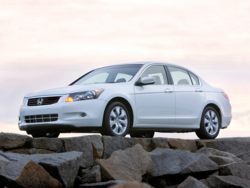
IT’S taken ages but Honda Australia is getting close to introducing the new “cost down” hybrid petrol/electric Insight here to compete with Toyota’s Prius in the small hybrid passenger car segment. One wonders what “cost down” actually means?
Both companies prefer to call their hybrids “medium” cars but they aren’t really in that size category apart from possibly the wheelbase.
The Honda Insight looks a lot like Prius because, according to the designer, “aerodynamics dictate a certain style”.
It has a good Cd 0.28 aerodynamic rating.
But Insight has a battle on its hands if it’s to take on Prius which has secured a firm grasp on the tiny hybrid market in this country.
Prius is into generation three and is being pushed by the corporate might of Toyota.
Insight is not only late on the scene and a curiously-styled local replacement for Civic hybrid but also has a smaller capacity petrol engine at 1.3 litres compared to Prius’ 1.8-litre unit.
The overall power and torque output of Insight is less than Prius.
The hybrid powertrain is also less sophisticated and is based around what Honda calls an integrated motor assist system that’s been around for years in various earlier Honda hybrids including the first, infamous, three-door Insight from a decade ago.
The powertrain package has been refined and reduced in size over the years and there’s some new technology called eco-assist to make it more fuel efficient through optimising engine functions and improved driving habits and is also less polluting.
Drive is to the front wheels by a continuously variable automatic transmission and the body is lightweight to help fuel efficiency and performance.
Electric power comes from a nickel-metal-hydride battery (still not lithium-ion) and it powers a low friction, brushless direct current motor.
Honda had a close eye on costs when developing the new Insight and saved a bundle by building it around the new Honda Jazz platform (with changes).
It’s a five-seat, five-door hatchback that gets a five-star crash rating.
But the jury is still out on the fire safety of this and all hybrids because of potential electrical short circuits in a collision that could cause an inferno and/or toxic fumes if the petrol tank is breached.
Hybrids are also coming under safety scrutiny in rollover crash scenarios because of the heavy weight in the lower section of the vehicle from batteries, electric motor, petrol engine, cooling system and wiring potentially crushing the roof.
After hitting the Japanese market earlier this year, Insight has filtered through to other countries and it’s Australia’s turn later next year.
The car has gradually lost some of its styling pizzaz evident on the run up to production status and now looks like a Tokyo taxi with cheap wheel covers, minimal body bright work and a plastic interior.
Hopefully it is capable of recording incredible fuel economy and is as cheap as chips to buy.
Don’t hold your breath because the talk is of about $35,000. That buys a lot of petrol or diesel.






















